-
Machine learning catches the latest slang and keywords
-
Screens content across 18+ categories
-
Activity can only be viewed if it’s triggered
Advertiser Disclosure
All About Cookies is an independent, advertising-supported website. Some of the offers that appear on this site are from third-party advertisers from which All About Cookies receives compensation. This compensation may impact how and where products appear on this site (including, for example, the order in which they appear).
All About Cookies does not include all financial or credit offers that might be available to consumers nor do we include all companies or all available products. Information is accurate as of the publishing date and has not been provided or endorsed by the advertiser.
Editorial Policy
The All About Cookies editorial team strives to provide accurate, in-depth information and reviews to help you, our reader, make online privacy decisions with confidence. Here's what you can expect from us:
- All About Cookies makes money when you click the links on our site to some of the products and offers that we mention. These partnerships do not influence our opinions or recommendations. Read more about how we make money.
- Partners are not able to review or request changes to our content except for compliance reasons.
- We aim to make sure everything on our site is up-to-date and accurate as of the publishing date, but we cannot guarantee we haven't missed something. It's your responsibility to double-check all information before making any decision. If you spot something that looks wrong, please let us know.
Overall screen use among teens and tweens increased by 17% from 2019 to 2021, growing more rapidly in those 2 years than in the 4 years prior, according to a 2021 survey.[1]
Parents can choose to limit time spent online, but is it enough to keep your child safe? That’s where parental control apps like Bark can be a parent’s best friend.
Bark is an online safety tool that empowers families to monitor content, manage screen time, and filter websites to help protect kids online. It provides an alternative to constant surveillance with a heavy emphasis on monitoring your child’s online activity.
Bark monitors texts, photos, videos, and 30+ social media platforms and apps. It has industry-standard parental control features, easy-to-use navigation, and substantial customer support. It also offers real-time location tracking and allows parents to monitor unlimited devices.
Bark prices and subscriptions
Bark features
Our experience testing Bark Premium
Bark customer support
Does Bark collect your data?
Bark alternatives
Bark review FAQs
Bottom line: Is Bark really worth it?
Bark review at a glance
| Price | $5.00–$49.00/mo |
| Number of devices supported | Unlimited |
| Website filtering | Yes |
| Social media monitoring | Yes |
| Text message monitoring | Yes |
| Email monitoring | Yes |
| Screen time management | Yes |
| Supported devices | Windows, macOS, Chromebooks, iOS (iPads and iPhones), Android, Samsung tablets, Kindle Fire tablets, Chrome, Edge |
| Learn more | Get Bark |
Bark parental controls expert overview
Bark’s specialty is monitoring, which helps keep kids safe by sending alerts about potential issues. Rather than allowing parents to spy on their kid’s online activities, Bark takes a unique approach and encourages parents and children to discuss online safety, which improves digital literacy.
That said, if you’re looking for a rundown on every text message sent and received, you won’t find that with Bark.
While parents aren’t able to read all of their child’s text messages, Bark does send alerts if it detects any issues like bullying, self-harm, and sexual predators in your child’s communications. The alert includes a copy of the flagged content and recommended actions to help you navigate the situation.
Unfortunately, the alerts aren't instantaneous, since Bark analyzes large amounts of data. Another of Bark’s drawbacks is that you can’t block messages, contacts, and phone calls from your child’s device. While you can block the internet from any device, blocking incoming messages, contacts or phone calls can only be done using something called the Bark Phone (which is Bark’s most expensive monitoring “plan,” and we’ll describe in more detail later in this article).
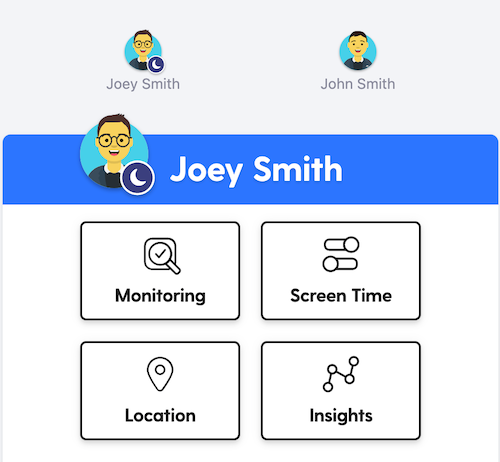
Bark pros and cons
- Machine learning catches the latest slang and keywords
- Monitors 30+ social media apps
- Screens content across 18+ categories
- Activity can only be viewed if it’s triggered
- Alerts are delayed
Bark prices and subscriptions
Bark offers a few different levels of monitoring for parents to choose from. Bark Jr. allows parents to create screen time controls, filter specific websites or apps, and get location alerts when their child leaves or arrives at frequently visited places like school, home, or practice locations. Bark Jr. is available on unlimited devices.
Bark Home is the next monitoring tier, offering support for unlimited devices and accounts, website and app blocking, and screen time management. Bark Home is a physical device that connects to your router and allows you to manage internet-connected devices, from TVs to gaming consoles and more.
Bark Premium allows Bark to monitor phones, tablets, and other devices. In addition to supporting unlimited devices and accounts, Bark Premium comes with website and app blocking as well as screen time management, Bark Premium also offers location check-ins and alerts, text, app, and social media monitoring, and alerts for potential dangers like bullying, violence, online predators, profanity, nudity and more.
Bark’s most expensive monitoring “plan” is actually a device called Bark Phone. This Samsung phone offers all of the amenities featured in Bark Premium and Bark Home: unlimited devices, website and app blocking, screen time management, location check-ins and alerts, as well as text, app, and social media monitoring and alerts.
Bark Phone also offers remote alarms for parents to set one-time or recurring alarms on their child’s Bark Phone. For an added layer of surveillance, Bark Phone’s texts can’t be deleted without permission. In addition, Bark Phone requires app and contact approvals so you know what your kids are downloading and who they’re talking to.
Bark parental control app comparison
| Features | Bark Jr | Bark Home | Bark Premium | Bark Phone |
| Price | $5.00/mo | $6.00/mo | $14.00/mo | $49.00/mo + cost of phone |
| Number of devices | Unlimited | Unlimited | Unlimited | Unlimited |
| Website filtering | ||||
| Screen time management | ||||
| Social media monitoring | ||||
| Location tracking | ||||
| Text message monitoring | ||||
| Email monitoring | ||||
| Internet search monitoring | ||||
| Cyberbullying and online predator alerts | ||||
| Details | View on Bark.us | View on Bark.us | View on Bark.us | View on Bark.us |
Bark’s monitoring services come at a marginally higher price than other online monitoring services. But we believe you get what you pay for, and Bark’s monitoring is superior to its competitors.
Aside from the long list of apps, websites, and email hosts Bark monitors, machine-learning searching for triggering keywords is an innovative technology in monitoring services. While some parents may prefer more surveillance and the ability to read every text message sent and received by their child, we like Bark’s unique approach, which fosters communication and open dialogue with your child.
Our pick? We like the Bark Premium plan. The text, app, social media, and web search monitoring technology add a digital safety net for your child, scanning their online activities for worrisome content. Parents can monitor web searches, saved photos and videos, and receive alerts when issues like cyberbullying, online predators, and mental health situations arise.
Bark Premium also teaches parents how to address issues, giving tips and advice from child psychologists. Combined with the ability to filter out specific websites or you can choose between 19 different categories to help protect your child from inappropriate content, the monthly price tag is well worth it, in our opinion.
Bark features
Bark offers features and amenities that help parents feel at ease as their kids learn to navigate sites, apps, social media, and the responsibility of having a phone. In addition to parental monitoring, Bark also offers:
- Content monitoring on social media and phone apps
- Text message, email, and browser monitoring
- Screen time management
- Location tracking
- Activity reports
Content monitoring
On the Bark Premium plan, Bark scans your child’s connected accounts 24/7 and alerts you via text, email, and in-app, when possible issues are detected.
Bark uses machine-learning algorithms to recognize potential threats, including body image/eating-related issues, bullying, depression, drug- and alcohol-related content, hate speech, medically concerning content, phishing, predatory behavior, risky app and site usage, self-harm, suicidal content or ideation, sexual content, violence, weapons and more. Bark’s algorithms also analyze conversational content rather than just searching for triggering keywords.
Bark recognizes that what triggers one user may be different for another user and allows parents to adjust the alert sensitivity.
Social media and phone apps monitored by Bark
| iOS | Android | |
| Apps monitored by Bark |
|
|
Social media sites and apps are growing in popularity, as younger kids gain access to phones and internet-connected tablets. Bark helps keep kids safe online by filtering content they see, scanning their messages for inappropriate content, and allowing parents to safeguard internet activity by setting screen time guidelines and website boundaries.
On all platforms, Bark can scan and alert you to issues in your child’s posts, including text in captions, images, and videos. On Android and Amazon Fire tablets, Bark can also scan and alert you to issues found in direct messages and searches.
Parents can determine which websites their kids can and cannot visit, including blacklisting or blocking websites, preventing their child from visiting those sites entirely, and receiving notifications if their child tries to access the blacklisted sites.

Text messages
Bark monitors text conversations on the default text app of your child’s phone, including Apple’s iMessages, Samsung Messages, Google Messages, and the Messages app installed on the Bark phone. The Bark Premium plan can also monitor pictures, audio, or video sent via messaging apps.
Bark’s text message monitoring is one aspect of online protection that leaves some parents wanting a little extra surveillance. Families don’t get access to every single message a child sends, but Bark does send alerts for trigger issues like bullying, self-harm, sexual predators, and more. The alert includes a copy of the content and suggested actions to help parents handle the situation.
One of Bark’s notable features is its ability to monitor your child’s email account. Bark can monitor Comcast, Gmail, Outlook, Yahoo, and iCloud email accounts.
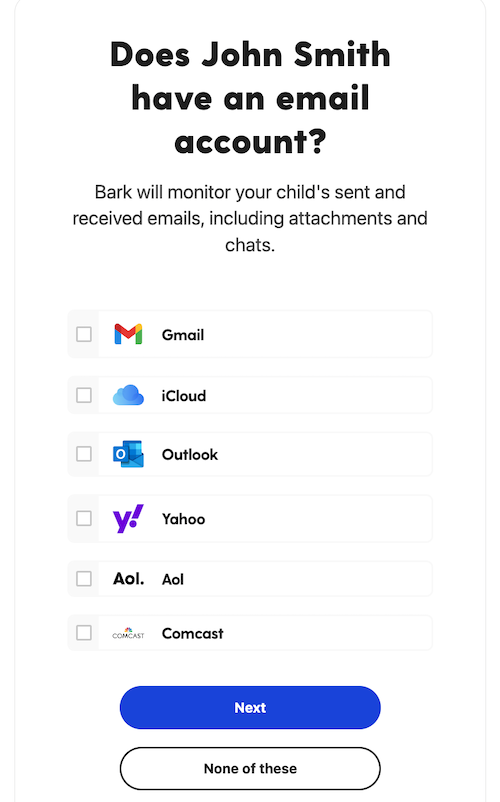
With Bark’s email monitoring, your child’s sent emails, received emails, and image attachments are scanned. It’s worth noting that at this time, Bark does not scan the images inside the body of an email. So, for example, if someone emailed your child a photo of a gun in the body of an email, Bark might not detect it.
Web browsers
Bark also monitors computer web browsing on Google Chrome and Microsoft Edge. This includes website visits, searches, and even incognito browsing, when you install the Bark browser extensions.
Parents are alerted via email or text message when their child tries to visit a restricted site. Bark also allows parents to block sites completely or restrict specific content categories like streaming sites, gaming sites, pornography, and more.
Screen time management
Not only does Bark allow you to monitor what your child sees on the internet, but it also helps you manage when your child can access the internet with their screen time monitoring.
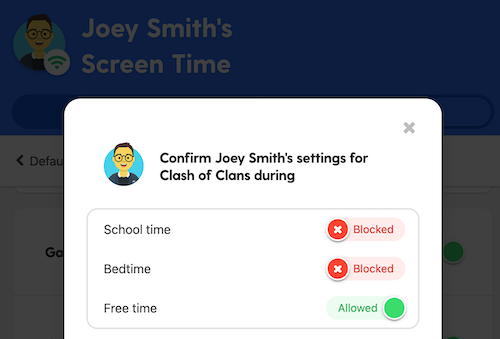
You set the rules — no social media after bedtime? You get to decide. Want to block YouTube during school hours? That’s your prerogative. Choose which apps and sites your child can access during different times of the day, like free time, school time, and bedtime. In the Screen Time settings, you can choose when and if they can access which apps and websites.
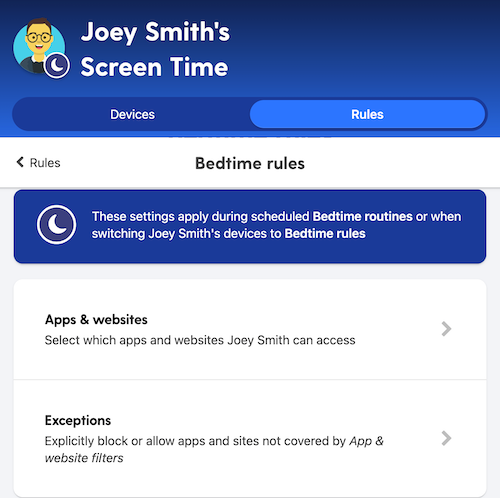
Bark also offers category blocking in addition to app blocking. You can block specific apps, like Facebook, Instagram, or all social media apps by blocking the category.
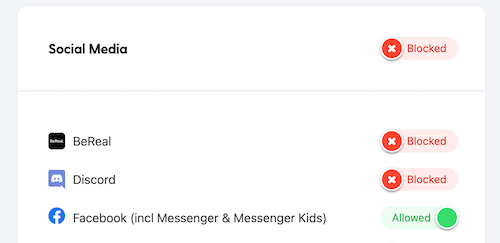
Location tracking and geo-fencing
Bark offers two location features: check-ins, and location alerts, each serving a separate and distinct purpose.
The parent initiates check-ins for immediate location updates. A check-in requires the child to open the app and respond. A notification is then sent to the parent with the child's exact location.

Location alerts are notifications triggered whenever your child leaves or arrives at a pre-set location, like a practice facility, school, or another frequently visited location. The parent dashboard shows the location history for the past 7 days. This real-time location tracking helps give parents peace of mind that their child is where they should be at any point in the day.
Activity reports
Parents can access regular activity reports in Bark’s parent dashboard. There, you can find general insights about your child’s screen use over a period of time. You can see information, like recently installed apps, top contacts, and more.
Each week, Bark sends a report summarizing your child’s activity over the past 7 days. In our opinion, we prefer to utilize the dashboard. While alerts aren’t instant on the dashboard, it’s a lot faster than waiting 1 week for the summary report from Bark. Bark sends alerts through email, text, or in the Bark app, if it spots a potential issue in your child’s online activities.
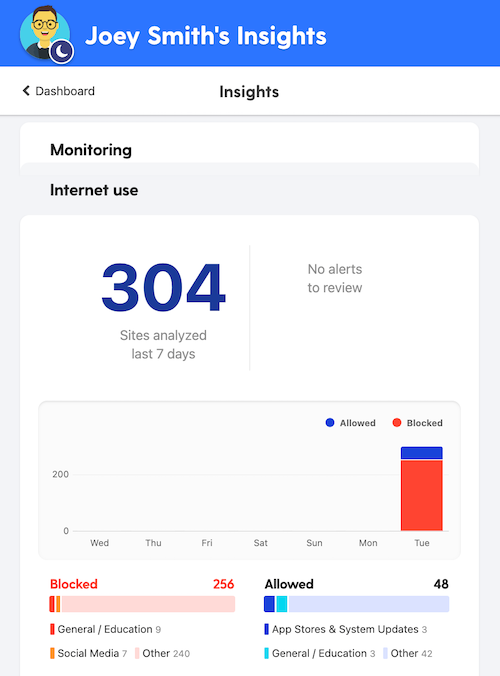
Our experience testing Bark Premium
Overall, our experience with Bark Premium was straightforward and pleasant. We were impressed with the monitoring, alerts, locations, and screen time parameters the app allowed us to set.
Bark Premium setup
Installing and setting up the Bark Premium account only took a few minutes, but you need to connect each of your child’s devices that you want to monitor, which was a little time-consuming.
First, you’ll need to set up a child account. Enter your child's information, including their name and birthday, then select any devices and apps you want monitored. Bark provides straightforward step-by-step instructions, so you shouldn’t have any difficulty.
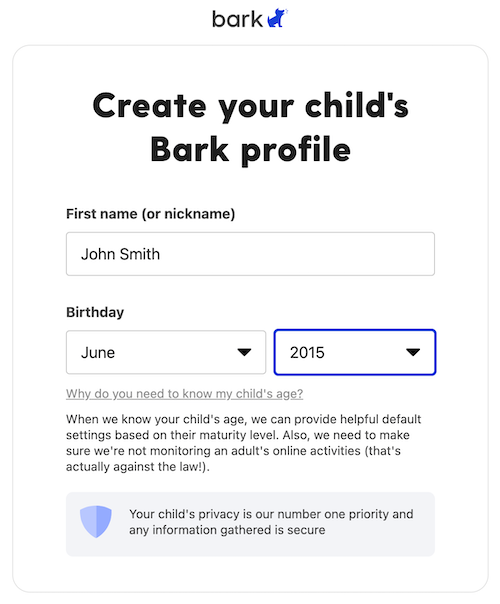
Once you’ve connected devices like iPads, Amazon Fire tablets, Androids, etc., you must connect your child’s accounts that need monitoring. Email accounts, social media accounts, streaming accounts, and more can be connected for monitoring.

Bark does give the option for the child to link all their accounts as well. For additional monitoring, you can also download the app on your child’s devices.
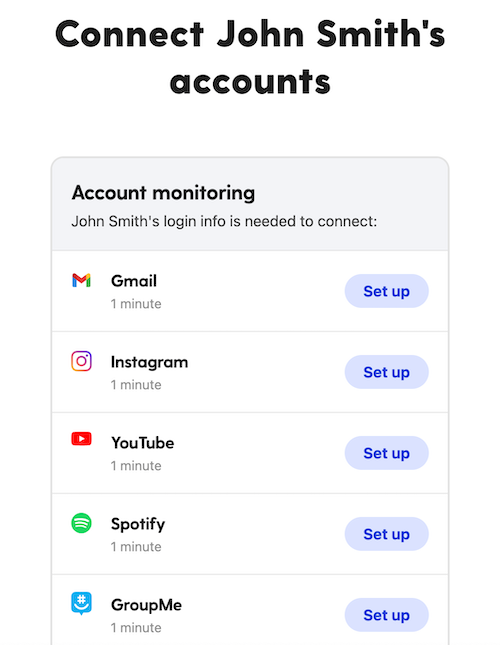
Bark Premium monitoring in action
Once we set up our Bark account and linked our child’s social platforms, devices, and email addresses, we were ready to go.
Parents can access four tabs in the parental dashboard: monitoring, screen time, location, and insights. In the monitoring section, parents can manage devices and which settings they choose to allow on each device. There, you can adjust the monitoring algorithm's sensitivity as well.
Screen time allows parents to set rules, routines, and schedules for their child’s screen time. In this tab, you can also pause a device by blocking the internet for a determined amount of time.
In the location setting, parents can request a check-in and check location activity for their child. You can also track a device’s location in this tab.
The insights tab is where your child’s online activities are analyzed. You’ll get a list of top contacts for the past 7 days, as well as the alerts for the past 7 days. You’ll also be able to find a graph of sites visited and the number of those sites that were blocked and approved.

While the alerts weren’t instant, we were impressed by how quickly the alerts arrived. We received a text and email message within minutes, letting us know there was an alert for us to review.
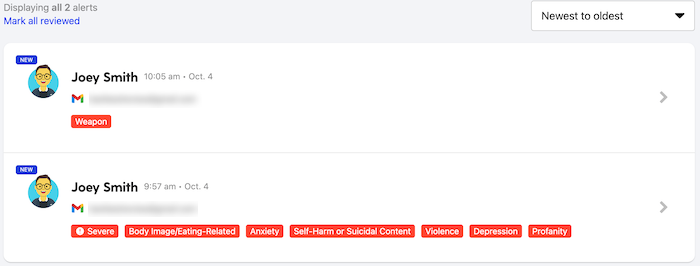
Bark customer support
| Support type | Bark |
| Email or live chat | Yes — email and live chat |
| Phone | |
| Online guides or forums |
Bark offers email, live chat, and online forums and guides. We were impressed with the information available in the online forums and guides. Bark’s YouTube channel, linked on its Contact Us page, has more than a dozen videos, with tutorials on setting up Bark Phone, enabling screen time and monitoring for various devices, using parental controls on various web browsers, pausing and resuming internet access, and more.
During our testing, we used the chat feature, but the bot didn’t answer our question and instead linked us to a few articles. The bot, not the linked articles, ultimately answered our question, but we did find the answer later in a different article.
We also emailed Bark’s customer support a generic question, and we had a resolution within an hour.
Does Bark collect your data?
Bark automatically collects information from you when you visit their site, including your device’s IP address, browser, operating system, and statistics about your use. If you connect to Bark through a mobile device, it may also collect information about your device.
According to Bark’s privacy policy, it “may” collect data from online interactions through other websites, including social media sites, email accounts, or other interactive sites. Bark also uses cookies to remember your site preferences and third-party cookies to serve relevant ads. It’s worth noting that Bark also collects:
- Web forms
- Registration data
- Account data
- Location information
Bark’s privacy policy explicitly states it does not sell information to third parties.
Bark security
Bark is secured with several layers of protection to ensure user data is safe. All databases, physical servers, and web sessions are encrypted to help secure your child’s data.
Bark is compliant with privacy regulations required by law, including:
- COPPA: Protects minors from deceptive marketing practices
- FERPA: Gives rights to families over school records
- CIPA: Requires schools to adopt internet safety policies
- AB 1584: Allows schools to contract with third parties
- SOC 2 Type II: Evaluates the effectiveness of security systems
Bark alternatives
There are a lot of factors when taking your child’s online safety into account. While Bark does a good job monitoring content, there are other things to consider, including price and what features are most important to you. Here are some other alternatives we recommend.
- Aura: This identity theft service provides real-time alerts, antivirus protection, a VPN, and parental controls that allow parents to block sites and monitor time spent on apps and games.
Get Aura | Read Aura Review - McAfee: This antivirus software has everything you need — a firewall, a virtual private network (VPN) to secure your Wi-Fi connection, privacy controls, and parental controls to help manage your child’s online activity.
Get McAfee | Read McAfee Review - Bitdefender: Bitfender offers powerful antivirus software with premium features like a password manager and anti-theft protection. As a bonus, the parental controls display information in an easy-to-read dashboard.
Get Bitdefender | Read Bitdefender Review
Bark review FAQs
What are the pros and cons of the Bark app?
Bark is excellent at monitoring and giving parents more peace of mind as their child navigates a new world of devices, apps, and web surfing. But some parents are looking for more surveillance and more of a play-by-play of their child’s online activities, and Bark doesn’t offer that.
Can my child delete the Bark app?
The short answer is, yes, they can. But Bark has suggestions for keeping the app on your child’s phone. The latest app versions for Androids set up uninstall protection with a device code. For Apple products, Bark recommends using Apple Screen Time, which prevents your child from deleting apps without your permission.
What age is Bark recommended for?
Bark is recommended for any child of any age who is learning to navigate the internet's complexities and may need additional protection and guidance. We recommend any child, tween, or teen with a smartphone is the right age.
Does Bark show deleted texts?
In some cases, yes. Bark will not show all deleted text messages for you, but it can analyze and alert you to concerning content found in some deleted text messages.
Will my kids know Bark is installed?
Yes, and that’s part of Bark’s strategy. Bark encourages parents to facilitate conversations about important topics like online literacy and safety with children before installing Bark.
Bottom line: Is Bark really worth it?
Bark is worth it thanks to its unique and extensive features, including monitoring of 30+ apps and websites. Bark also offers location services and screen time management, as well as support for an unlimited number of devices, which is rare for parental control apps.
That being said, Bark alerts you only when the app detects something risky or potentially problematic, and those alerts aren’t instantaneous.
Bark is worth the cost with the understanding that there are a few drawbacks. If you’re looking for a parental control app that offers monitoring with an opportunity for discussion and gives your child more freedom online, Bark may be for you. If you’re looking for a surveillance-heavy parental control app, you may want to research other options. Your family’s protection is of utmost importance and it’s important to find parental control apps and identity theft protection for families that fit your family dynamic and needs.
-
Machine learning catches the latest slang and keywords
-
Screens content across 18+ categories
-
Activity can only be viewed if it’s triggered
[1] What’s the average age when kids get a social media account?
[2] The Common Sense Census: Media Use by Teens and Tweens, 2021






